The Ford Escort RS Cosworth----Also Fast, Successor Of The Sierra Cosworth, Also Successful in Motorsport.
Yes, today we’re covering the Ford, Escort RS Cosworth.A car was designed to qualify as a Group A car in the WRC, in which it would compete in from 1993 to 1998. It was available from ‘92 to ‘98 in VERY limited numbers.
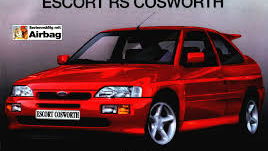
Yes, today we’re covering the Ford, Escort RS Cosworth.A car was designed to qualify as a Group A car in the WRC, in which it would compete in from 1993 to 1998. It was available from ‘92 to ‘98 in VERY limited numbers. And by the time it came out, the Whale-Tail was back, Wilder Than Ever Before. The main Selling Point of this car, was, aside from the wing, and the fact that its a Cossie(I assume), was the all-new(Sort of) 2.0 Cosworth YBT Engine shoved under the hood,which apparently had 227 bhp, though that was with early cars using Garrett T3/T04B Turbo’s(YBT Engines), while Later Cars used a smaller, T25(YBP Engines), in an effort to reduce the gaping chasm of Turbo Lag. But first up, here’s what you probably want to know about it.
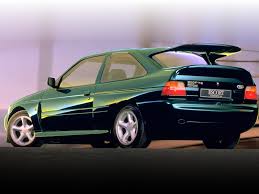
Ford developed the car around the chassis and mechanicals of its spiritual predecessor, the Sierra Cosworth to accommodate the larger Cosworth engine and transmission, whilst clothing it in Escort body panels to make it resemble the standard Mk V. Designed under the guidance of Rod Mansfield and John Wheeler of Ford’s SVO department, the styling was carried out during 1989, a year before the standard Escort was launched, by Stephen Harper at MGA Developments in Coventry. The spoiler was added by Frank Stephenson, who originally proposed a three-deck piece. The body tooling was created by coachbuilders Karmann at their facility in Rheine, Germany, where the cars were manufactured.
Changes were made to the engine management system and a new turbocharger was fitted. Permanent four wheel drive with a 34/66% front/rear split came courtesy of an uprated five speed gearbox as used in the Sierra Cosworth. Recaro sports seats came as a standard fitment. Later production models were available without the Whale-Tail although the majority were still ordered with it. Like its Sierra predecessor, they’re commonly called Cossies by enthusiasts.
The Escort Cosworth was a rare car, with 7,145 vehicles produced from the start of production on 19 February 1992 until the last car rolled out of the factory on 12 January 1996.
A tiny number were unofficially imported to the United States, where it was considered one of the greatest performance Fords of all time.Apparently.
The car’s top speed was 150 mph(Basically as fast as the Sierra Sapphire), which rivalled lower-end supercars including the Audi Quattro, BMW M3, Nissan 300ZX and Toyota Supra, and comfortably outperformed traditional Hot Hatches like the Golf GTI. It was much faster than the 126 mph which the Escort RS2000 and earlier Escort RS Turbo were capable of.
Two versions were produced. The initial 2,500 units were “homologation specials” used to get the FIA accreditation for entry into the World Rally Championship. They were fitted with a Garrett T3/T04B turbocharger. Among these initial units, a handful were badged as Motorsport versions, these lacked certain refinements such as a sunroof and sound deadening.
The initial cars included features that, although they made the Cosworth a more effective car, did not enhance it as a road vehicle, and once the rules were satisfied Ford attempted to make the car less temperamental and easier to drive under normal conditions. The second generation, starting production from late 1994, were fitted with a Garrett T25 turbocharger, a smaller unit which reduced turbo lag and increased usability in everyday driving situations. With these later models, the ability to delete the whale-tail became an option. Why you’d do so is way beyond me, but you’re doing it wrong if you decide to remove that Whale-Tail.
The Cosworth YBT(T03/T04B-equipped engine) apparently produced 227 hp at 6,250 rpm, while torque was 229 lb-ft at 3,500 rpm on 95 RON petrol. Vmax was 137 mph without the Whale-Tail,and 150 mph WITH the Whale-Tail(See, the Escort goes faster With The Whale-Tail, all the more the reason you should have left it on the car, Genius(Basically anyone who decided to remove it).)while 0-62 takes 5.7 or 6.1 seconds. The slower acceleration time is for the heavier ‘Lux’ edition. The car used a 5-Spd Ferguson MT-75 Transmission, and weighed 1275 Kilos(Presumably ‘Standard’ Cars) to 1320 kilos(Presumably the ‘Lux’ Edition.).
The Cossie was the first mass production car to produce downforce at the front and rear (front 45N at 70 MPH, adjustable splitter in middle position, rear 190N, with the wing attached). Now we move on to its success in Motorsport.
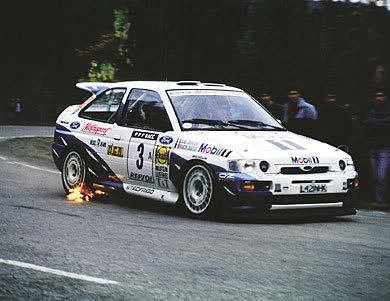
The rationale behind the Escort Cosworth’s design was that it should win the World Rally Championship. This it did not achieve, but it did win eight events between 1993 and 1996 as a Group A car, and two more in World Rally Car guise in 1997-8, before it was replaced by the Focus WRC.
The Escort Cosworth was developed by the Ford works rally team during 1991 and 1992. Its first appearances, prior to homologation, were in the Spanish championship, in the hands of Jose Maria Bardolet, and on the 1992 Scottish Rally, where it was driven by Malcolm Wilson, who was also the lead development driver. Wilson was not formally competing in the event, but his stage times were faster than those of winner Colin McRae. During the latter part of the 1992 season, development of the Sierra Cosworth came to an end, and the works team drivers Francois Delecour and Massimo Biasion concentrated on readying the Escort for competition.
A Ford Escort RS Cosworth on a stage rally, driven by British driver Malcolm Wilson.
On the Escort’s first outing at World Championship level, the 1993 Monte Carlo Rally, Delecour took the lead with Biasion second. The pair led the event until the final night, when a late charge by Didier Auriol, driving a Toyota Celica, saw him win, with the Fords coming in second and third. Nevertheless, the new car had demonstrated its potential, which was underlined the following month when Malcolm Wilson, driving a car prepared by his own team, briefly led the Swedish Rally before retiring after an accident. The works team returned for the Portuguese Rally: Delecour led almost from the start and won the event with Biasion second, establishing both car and driver as serious contenders for that year’s World Championship. Delecour won again in Corsica, and Biasion in Greece – his first win for three years – putting them first and second in the drivers’ championship, and Ford in the joint lead in the manufacturers’ title. However, during the second half of the season Toyota driver Juha Kankkunen won in Argentina, Finland and Australia, whilst with the exception of Delecour’s second place (behind Colin McRae) in New Zealand the Fords’ results were relatively poor, giving Toyota the manufacturers’ title. Both works Escorts then retired on the San Remo Rally, Delecour after an accident and Biasion with engine failure after a radiator hose split, but the event was won by Italian Franco Cunico, in a privately entered Escort Cosworth. It was the first time in several years that a privateer had won at this level, and in doing so he outpaced the works Lancia Delta Integrale of reigning World Champion Carlos Sainz, demonstrating the superiority of the Escort over the previously dominant Lancia. Nevertheless, the result was a disappointment for Ford since, although Delecour won the penultimate round of the season, in Catalunya, he lost the world title to Kankkunen.
Delecour and Ford were tipped as serious contenders for the 1994 World Championship, especially after Delecour’s victory on the Monte Carlo Rally. However, Delecour retired from the second round of the championship, in Portugal, with engine failure, and a few weeks later was injured in a road accident, which forced him to miss the next four rounds. Biasion finished third in Portugal, but he was unable to keep up with the Toyotas, and his results did not improve thereafter, amid reports that his relationship with the team was deteriorating. He left at the end of 1994, and did not drive again at World Championship level. In Delecour’s absence the second Escort was driven by a succession of temporary drivers, including 1981 World Champion Ari Vatanen(Yep, the driver of Group B’s monstrous 205 T16 Peugeot, and the 405 T16 Pikes Peak,We’ll cover that another time), young Belgian driver Bruno Thiry and Franco Cunico. With the exception of Vatanen’s third place in Argentina (followed by retirement after a major crash in New Zealand whilst challenging for third), results were indifferent and the team faced some criticism for its dependence upon Delecour. The final guest driver proved a greater success, however: on a one-off drive for the team, Tommi Makinen won the 1994 1000 Lakes Rally. Delecour returned to the team on the same event but was still not fully fit and finished fourth, before retiring on the final two rounds. Thiry rounded off a disappointing season for the team by taking third place on the final round, in Great Britain.
The Ford works team closed at the end of 1994, and the rally programme was handed over to the Belgian RAS Sport team. Biasion was replaced by Bruno Thiry, whilst Delecour stayed with the team. The season was shortened to eight events and servicing was much more restricted than in previous seasons. Group A cars also had to run with a smaller turbo restrictor than previously, which was a particular handicap for Ford, since the rally Escort’s seven-speed(I thought Rally Cars used 5-6-speeds) gearbox was apparently ‘not well suited to a lower-revving engine’. Delecour, although complaining quite a lot in interviews about the rule changes, finished second on the Monte Carlo. Bruno Thiry then led the Corsica Rally and looked likely to win, until the unthinkable happened-A wheel bearing failure, which under previous rules his mechanics would have been able to rectify, put him out of the rally. Delecour finished second, but there were no further top-three placings that season and Ford finished at the bottom of the manufacturers’ championship.
The experiment with RAS not having been successful, Ford took its rally team back in-house for the 1996 season. Thiry stayed as second driver, but Delecour left the team and was replaced by Carlos Sainz. Sainz took third place in the driver’s championship, with a win in Indonesia and second in Sweden and Italy. Nevertheless, the Escort was by this time outclassed by the Mitsubishi and Tommi Mäkinen, who won that year’s title, and towards the end of the season interest switched towards the following season and the incoming World Rally Car rules.
Although it required some special dispensation, Ford were allowed to adapt the Cosworth into a World Rally Car, to serve as a stopgap until a purpose-built WRC was developed. The semi-trailing-arm rear suspension, judged one of the Cosworth’s weak points, was replaced with MacPherson struts, and modifications were made to the bodywork and transmission. The rally cars were to be run by Malcolm Wilson’s team, now known as M-Sport. During the 1997 and 1998 seasons, it went on to score two more victories by Carlos Sainz. With Thiry, Ari Vatanen (on a one-off podium-scoring basis at the Safari Rally after Thiry suffered an injury) and four-time World Rally Champion Juha Kankkunen now behind the wheel of the cars, the Escort name finally bowed out of works rallying altogether after a double-podium at the season-ending 1998 Rally of Great Britain.
Outside the World Championship, the Escort, like its predecessors, was highly successful at national and European championship level, winning many national rally titles and in 1994 Belgian driver Patrick Snijers won the outright European Championship driving a RAS Sport prepared car. It was also a successful Group N contender. Tuning parts were (and are) readily available, and lower-specification Escorts became a common feature on even relatively low-level rallies in Europe during the 1990s. They remain so, although many have been converted at least partially to World Rally Car spec.
The Escort also had a foray in Formula One albeit as its Safety Car. It was, in fact, used during two Grands Prix in the 1992 season to trial this new safety concept, which was officially introduced in the sport the following year (using other road cars). So, in short, the car wasn’t exactly the greatest of Rally Cars, but it did have some pedigree, and was just as, or if not more successful than the Sierra on which it was based on. How dramatic the Escort was back then, I can’t confirm now, but it probably was still pretty dramatic, even in the absence of RWD. How popular it is on low-level rallies I’m not sure, but it has to be a pretty popular choice, the Escort.
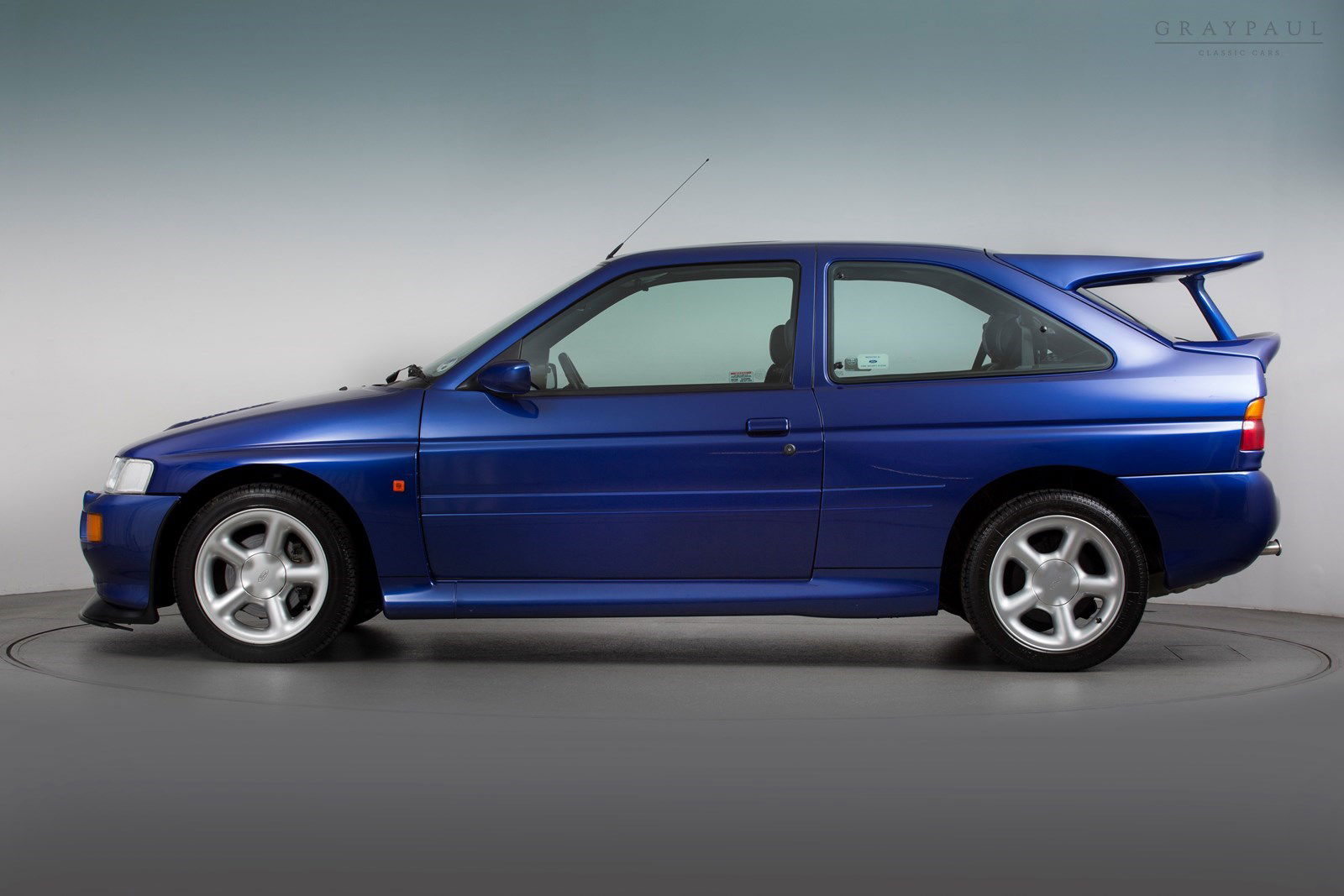
So, to conclude, the Escort RS Cosworth really did move the game on from the Sierra, it was as fast as a Sierra Sapphire, it had 4WD from the Sapphire 4x4 for the snow, which apparently proves quite useful in snowy countries, from what I understand, it played many roles in many places, from being THE car to own back in the ‘90’s(Although insurance and buying the thing back then was crippling) to being a Formula One Safety Car, which it probably did pretty well, it handled well, and was in fact used by the Police of the ‘90’s, presumably in a desperate bid to keep up with Joyriders…Most of all, Just Look At That Wing…And having had a quick look on carandclassic.co.uk, for these cars, unlike the Sierra I covered a while ago, you Should expect these things to go for anywhere over 15 000 pounds, really, to as much as say…70 000? So, if you want to bag yourself one of these, you either have to have good bargaining power, or come prepared with A LOT of Cash. Preferably both, though.
And on THAT Bombshell, you have just finished reading my article on the Escort Cosworth, I hope you enjoyed this one, feel free to send me suggestions on more articles, be it for me to create a new series, the ‘Quick Car Feature’ Series, or these ‘Full-Length’ Articles.Or advice, for that matter.
I’ll see you at the next one.

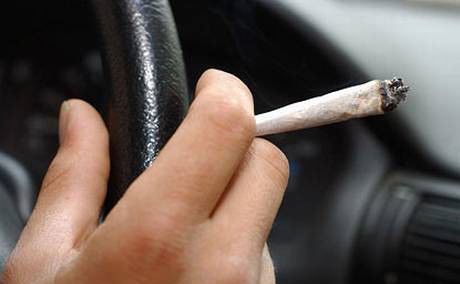
Comments
Matt Robinson
Good work on the article👍
45N and 190N really is so little you might as well not have it, 45N equals less than 5kg of weight at the front.
Still my dream car!
One of the all time great hot hatches. This one was at a car show I was at in July. Some fantastic modifications done to it.
[DELETED]